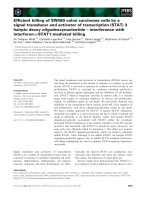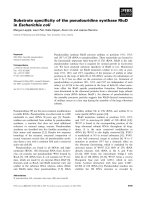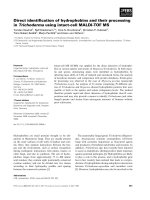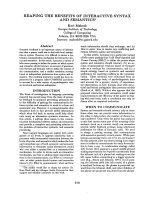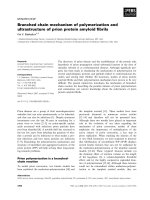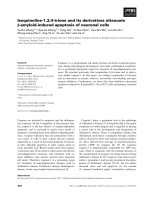Báo cáo khoa học: "METONYMY: REASSESSMENT, SURVEY OF ACCEPTABILITY, AND ITS TREATMENT IN A MACHINE TRANSLATION SYSTEM S" ppt
Bạn đang xem bản rút gọn của tài liệu. Xem và tải ngay bản đầy đủ của tài liệu tại đây (252.31 KB, 3 trang )
METONYMY: REASSESSMENT, SURVEY OF ACCEPTABILITY,
AND ITS TREATMENT IN A MACHINE TRANSLATION SYSTEM
Shin-ichiro Kamei* & Takahiro
Wakao
Computing Research Laboratory
New Mexico State University
Las Cruces, New Mexico 88003
Tel : 505-646-5466 Fax : 505-646-6218
Interact: &
* visiting researcher from NEC Corporation in Japan
ABSTRACT
In this article we outline a basic approach
to treating metonymy properly in a multil-
ingual machine translation system. This is
the first attempt at treating metonymy in an
machine translation environment. The
approach is guided by the differences of
acceptability of metonymy which were
obtained by our comparative survey among
three languages, English, Chinese, and
Japanese. The characteristics of the
approach are as follows:
(1) Influences of the context, individuals,
and familiality with metonymy are not
used.
(2) An actual acceptability of each meto-
nymic expression is not realized
directly.
(3) Grouping metonymic examples into
patterns is determined by the accepta-
bility judgement of the speakers sur-
veyed as well as the analysts' intui-
tion.
(4) The analysis and generation com-
ponents treat metonymy differently
using the patterns.
(5) The analysis component accepts a
wider range of metonymy than the
actual results of the survey, and the
generation component treats meto-
nymy more strictly than the actual
results.
We think that the approach is a start-
ing point for more sophisticated approaches
to translation in a multilirtgual machine
translation environment.
INTRODUCTION
Among others, both Lakoff and Johnson
(1980), and Fass (1991) divide metonymic
expressions into several fixed patterns such
as Part-For-Whole and Container-For-
Content. Sentence (1) is a typical
Container-For-Content metonymy and "this
glass" is replaced with "the liquid in this
glass" in its metonymic reading.
(1) "He drank this glass."
One of the things that has been less
focused on in previous literature on meto-
nymy is the problem of generation typically
in a machine translation system. For exam-
ple, even though the analysis component of
a machine translation system produces a
correct metonymic reading for sentence (1),
i.e. "the liquid in this glass" for "this
glass", if the result of the analysis com-
ponent is translated directly in word-for-
word manner, such an output sentence may
not be natural in the target language. On
the other hand, it may not be appropriate
either for the generation component to pro-
duce a sentence which is a direct transla-
tion of the original metonymy if the target
language does not allow such expression.
We think it is necessary for a multil-
ingual machine translation system to have
not only understanding of metonymy which
most previous works on metonymy have
focused on, but also proper ways to handle
generation of metonymy. In order to find
out ways to treat metonymy properly in a
multilingual environment, we have con-
ducted a survey on acceptability of various
examples of metonymy among English,
Chinese, and Japanese. The patterns of
previous works (Fass 1991, Lakoff and
309
Johnson 1980, Yamanashi 1987) seem to
be obtained from the intuition of the
analysts. However, we think that the pat-
terns which are based on the analysts'
intuition to begin with should be supported
and determined more precisely by the result
of this kind of survey. An analysis based
on actual data allows us to establish a clear
set of patterns and sub-groups, for example
to decide whether we require either
Producer-For-Product (Lakoff and Johnson
1980) or Artist-for-Artform (Fass 1991), or
both of them.
A SURVEY OF METONYMY
A comparative survey on acceptability of
metonymic expressions in English, Chinese
and Japanese has been conducted. All of
the 25 sentences which are used in the sur-
vey are taken from metonymy examples in
English in previous works (Lakoff and
Johnson 1980, Fass 1991, Yamanashi
1987). We asked native speakers of the
three languages to score the acceptability of
each sentence. Direct translations were
used for Chinese and Japanese. The dif-
ferent languages show differences in accep-
tability (for the details, Kamei and Wakao
1992).
Based on both intuitive analyses and
the result of the .survey, we have esta,
blished four major patterns, and several
sub-groups for the first pattern (Locating)
as shown in Appendix A. The patterns are
1) Locating, 2) Emphasis of one aspect, 3)
Abstract and collective entity for its con-
sisting concrete items, and 4) Information
conveyer for information giver.
For example, sentence (2) belongs to
the second group of Locating pattern (Pro-
ducer for Product). Examples of "Ford",
"Picasso", "Steinbeck" and "Bach" also
belong to this group (see Appendix A 1.2).
These sentences are fully acceptable in
English and Japanese, however, their
acceptability is low in Chinese and sen-
tence (2) is completely unacceptable.
(2) "He read Mao."
On the other hand, sentence (3)
belongs to the fourth pattem, information
conveyer and giver. The tendency of the
pattern is that those examples in this pat-
tern are acceptable in English and Chinese,
but not in Japanese.
(3) "The sign said fishing was prohibited
here."
AN APPROACH TO TRANSLATING
METONYMY
An important point to realize is that actual
computational treatment of metonymic
expressions is determined by the accepta-
bility of the pattern to which the expression
belongs. Another important point is that
the analysis and generation components of
a machine translation system should treat
metonymy differently.
We believe that the main factors for
treating metonymy correctly in a multil-
ingual machine translation system are 1) its
universality, which can be a guideline for
the analysis component, 2) language depen-
dency, which can be used for generation,
and 3) others such as the context, culture,
and familiarity. We think that it seems
unrealistic to expect an actual machine
translation system to cope well with the
third of these factors at present. Given the
lack of such knowledge, our basic heuris-
tics for treating metonymy are as follows:
Even if some language shows the ten-
dency of unacceptability, if one or more
languages show acceptance in the group to
which the expression belongs to in the
result of the survey, the system should
accept it for analysis, and come up with
some metonymic reading using its infer-
ence mechanism (Iverson and Helmreich
1992, Fass 1991). Given such information,
the generation component should look at
the tendency of each language. If the tar-
get language allows a metonymic expres-
sion which corresponds to the original
form, then the system should produce a
direct translation since the translation
preserves the naturalness. However, if the
310
target language does not allow a meto-
nymic expression which corresponds to the
original form, then the system should use
the result of the metonymic inference and
come up with an acceptable translation.
We think that these basic heuristics
are a good starting point for more sophisti-
cated approaches to translation in a multi-
lingual environment. We intend as our
next step to implement our ideas using
existing systems such as the ULTRA MT
system (Wilks and Farwell 1990) and the
Metallel metonymic analysis program
(Iverson and Helmreich 1992).
APPENDIX A
Some of the metonymic sentences used in
the survey.
1. Locating
1.1 Container for Content
Dave drank the glasses.
The kettle is boiling.
1.2 Producer for Product
He bought a Ford.
He's got a Picasso in his room.
Anne read Steinbeck.
Ted played Bach.
He read Mao.
2. Emphasis of one aspect
We need a couple of strong bodies for
our team.
There are a lot of good heads in the
university.
3. Abstract entity for concrete entity
Exxon has raised its price again.
Washington is insensitive to the needs
of the people.
4. Information conveyer for information
giver
The T.V. said it was very crowded at the
festival.
The sign said fishing was prohibited
here.
REFERENCES
Fass, Dan. (1991). met*:A Method for
Discriminating Metonymy and Meta-
phor by Computer. Computational
Linguistics, 17 (1): 49-90.
Iverson, Eric and Helmreich, Stephen.
(1992). Metallel: An Integrated
Approach to Non-literal Phrase
Interpretation. Memoranda in Com-
puter and Cognitive Science, MCCS-
92-231 Computing Research Labora-
tory, New Mexico State University,
Las Cruces NM.
Kamei, Shin-ichiro and Wakao, Takahiro.
(1992). Metonymy: reassessment, sur-
vey of acceptability, and its treatment
in a machine translation system.
Memoranda in Computer and Cogni-
tive Science, MCCS92-236 Computing
Research Laboratory, New Mexico
State University, Las Cruces, NM.
Lakoff, George and Johnson, Mark. (1980).
Metaphor We Live By. London: Chi-
cago University Press.
Wilks, Yorick and Farwell, David. (1990).
A White Paper on Research in
Pragmatic-based Machine Translation.
Memoranda in Computer and Cogni-
tive Science, MCCS-90-188 Comput-
ing Research Laboratory, New Mexico
State University, Las Cruces NM.
Yamanashi, Masa-aki. (1987). Metonymic
interpretation and associative
processes in natural language. In
Language and Artificial Intelligence,
Makoto Nagao (ed): 77-86. Amster-
dam: Elsevier Science Publishers B.V.
311

